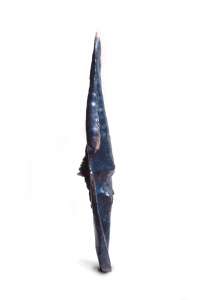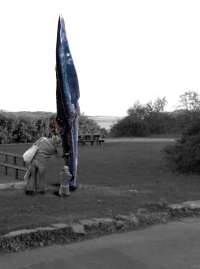Three Great Waves
Context
The notion of the ‘three great waves’ begin to appear in Irish texts as early as the 12th century. The 15th century Cath Finntrágha has its literary structure taken from the older Cath Trága Rudraigi which is set in the Dundrum area. The origins of the legend of these mighty waves however, can be traced as far back as the Bronze Age 1,500 BCE.
These waves are linked to the legend of Manannán Mac Lir, the mythical sea-god associated with the Tuatha dé Danann who also represents the link between the physical and spiritual world in pre-christian mythology. The archaeological significance of the waves remains speculative however, but all seem to protect inland access corridors and possibly ancient ore trading routes, appearing as they do in the following costal regions of Ireland: - Tonn Ruairidhe (alt. Tonn Ruray or Tonn Rudraige) here in Dundrum Bay, Co. Down - Tonn Tuaithe (alt. Tonn Tuaige) at the Bann Estuary near Coleraine, Co. Derry (sometimes called Túag Inber). A large sociopolitical gathering or assembly, the Aenach Tuaigh (linked again to Túag), was held at the Bann mouth according to early Irish literature. - Tonn Chlíodhna between Clear Island and Glandore, West Cork
According to different legends, the waves fulfilled a variety of functions: their roar is said to announce significant events, death of leaders and kings or potential disasters while Cúchullainn used his shield to reflect the echo of the waves to signal over the ocean.
Triplicity and multiples of ‘three’ were important numerical concepts in the Iron Age. La Téne style decoration of Irish Iron Age objects often bear the triskele - three connected spiral patterns of neolithic origin that appears in many European cultures. This is also evident in the three triskele ‘legs’ in the flag of the Isle of Man which derives its name directly from Manannán. The triskele is often interpreted as symbolising the life stages of growth, maturity and decline, all of which are also evident in the life-cycle of a wave.
Artistic Concept
In the proposed sculpture three inter-locking waves are set in a vertical position, emphasizing the link between sea, land and sky as well as ‘our world’ and the ‘otherworld’ which is drawn from the myth of Manannán. The cross-section of the three waves forms a triskele, an iconic symbol of the Irish Iron Age. The work itself is of an anthropomorphic characterization of Ireland’s magic waves whilst also suggesting the physical presence of Manannán.
Technical Specifications
The overall dimensions of the sculpture will be 3.8m high x 0.4m x 0.4m. The size of each of the waves will vary slightly from 0.35m to 0.45m in width. The average thickness of the bronze will be 2mm; the total weight is 125kg including internal structure.
Material and Process
The choice of material, bronze, directly links the sculpture with the period in which the myth first appears: the Bronze Age. A strong visual contrast is achieved by combining patinated bronze with highly polished surface areas. Sheet bronze, also known as gilding metal, has proven durability in the harsh conditions of costal and maritime environments. The material used will be 2mm (14 gauge) sheet bronze (gilding metal of 90% Cu /10% Zn). The work will be patinated with a deep green/blue patina with highlighted wave crests, similar to the model. Recycled resources together with regenerative and carbon-neutral fuels and materials will be used where appropriate and possible in all the processes at my own studio. A full environmental impact study (EIS) will be provided as part of the end-of-project report.
The process involves an ancient but now rarely used sculpture technique: repoussé. Sheets of bronze are cut and laid-out using pre-designed templates. The bronze sections are then annealed (heated) and shaped by hand. The metal is skillfully worked and drawn out with mallets and tools over wooden formers, anvil and sand bag and is annealed again. Finer detail is worked on a bed of pitch. The sections are welded together when the desired curvature and detail are achieved. After cleaning and sanding of the surface, a permanent patina is applied. Finally, the work is partially polished and waxed. The best known sculpture for which this technique was used is the Statue of Liberty in New York by Frédéric Bartholdi.
Foundation and Base
The structure will be fixed to a pre-installed base and reinforced concrete slab foundation. The total static ground load of the sculpture itself is approximately 1,250N. Foundation: 1.5m x 1.5m x 0.40m concrete slab foundations with 12mm re-bar cage, poured in situ and compacted to 330kg/m3, assuming reasonable ground conditions (total static ground load 4,250N). Foundations are 20cm below ground level and will be covered with soil and grass sods after installation. Alternatively, the base is left level with the ground and bronze lettering is inserted into the surface to spell out the names of the three waves and their locations. For this alternative, I recommend the use of Snowcrete with white marble aggregate and a polished surface for the finish which will give a better visual appearance. All fixings will be A4 grade stainless steel in combination with safety shear-nuts where exposed. A cast-in central 100mm stainless steel tube will receive the internal steel reinforcement of the sculpture.
Three Great Waves
Context
The notion of the ‘three great waves’ begin to appear in Irish texts as early as the 12th century. The 15th century Cath Finntrágha has its literary structure taken from the older Cath Trága Rudraigi which is set in the Dundrum area. The origins of the legend of these mighty waves however, can be traced as far back as the Bronze Age 1,500 BCE.
These waves are linked to the legend of Manannán Mac Lir, the mythical sea-god associated with the Tuatha dé Danann who also represents the link between the physical and spiritual world in pre-christian mythology. The archaeological significance of the waves remains speculative however, but all seem to protect inland access corridors and possibly ancient ore trading routes, appearing as they do in the following costal regions of Ireland: - Tonn Ruairidhe (alt. Tonn Ruray or Tonn Rudraige) here in Dundrum Bay, Co. Down - Tonn Tuaithe (alt. Tonn Tuaige) at the Bann Estuary near Coleraine, Co. Derry (sometimes called Túag Inber). A large sociopolitical gathering or assembly, the Aenach Tuaigh (linked again to Túag), was held at the Bann mouth according to early Irish literature. - Tonn Chlíodhna between Clear Island and Glandore, West Cork
According to different legends, the waves fulfilled a variety of functions: their roar is said to announce significant events, death of leaders and kings or potential disasters while Cúchullainn used his shield to reflect the echo of the waves to signal over the ocean.
Triplicity and multiples of ‘three’ were important numerical concepts in the Iron Age. La Téne style decoration of Irish Iron Age objects often bear the triskele - three connected spiral patterns of neolithic origin that appears in many European cultures. This is also evident in the three triskele ‘legs’ in the flag of the Isle of Man which derives its name directly from Manannán. The triskele is often interpreted as symbolising the life stages of growth, maturity and decline, all of which are also evident in the life-cycle of a wave.
Artistic Concept
In the proposed sculpture three inter-locking waves are set in a vertical position, emphasizing the link between sea, land and sky as well as ‘our world’ and the ‘otherworld’ which is drawn from the myth of Manannán. The cross-section of the three waves forms a triskele, an iconic symbol of the Irish Iron Age. The work itself is of an anthropomorphic characterization of Ireland’s magic waves whilst also suggesting the physical presence of Manannán.
Technical Specifications
The overall dimensions of the sculpture will be 3.8m high x 0.4m x 0.4m. The size of each of the waves will vary slightly from 0.35m to 0.45m in width. The average thickness of the bronze will be 2mm; the total weight is 125kg including internal structure.
Material and Process
The choice of material, bronze, directly links the sculpture with the period in which the myth first appears: the Bronze Age. A strong visual contrast is achieved by combining patinated bronze with highly polished surface areas. Sheet bronze, also known as gilding metal, has proven durability in the harsh conditions of costal and maritime environments. The material used will be 2mm (14 gauge) sheet bronze (gilding metal of 90% Cu /10% Zn). The work will be patinated with a deep green/blue patina with highlighted wave crests, similar to the model. Recycled resources together with regenerative and carbon-neutral fuels and materials will be used where appropriate and possible in all the processes at my own studio. A full environmental impact study (EIS) will be provided as part of the end-of-project report.
The process involves an ancient but now rarely used sculpture technique: repoussé. Sheets of bronze are cut and laid-out using pre-designed templates. The bronze sections are then annealed (heated) and shaped by hand. The metal is skillfully worked and drawn out with mallets and tools over wooden formers, anvil and sand bag and is annealed again. Finer detail is worked on a bed of pitch. The sections are welded together when the desired curvature and detail are achieved. After cleaning and sanding of the surface, a permanent patina is applied. Finally, the work is partially polished and waxed. The best known sculpture for which this technique was used is the Statue of Liberty in New York by Frédéric Bartholdi.
Foundation and Base
The structure will be fixed to a pre-installed base and reinforced concrete slab foundation. The total static ground load of the sculpture itself is approximately 1,250N. Foundation: 1.5m x 1.5m x 0.40m concrete slab foundations with 12mm re-bar cage, poured in situ and compacted to 330kg/m3, assuming reasonable ground conditions (total static ground load 4,250N). Foundations are 20cm below ground level and will be covered with soil and grass sods after installation. Alternatively, the base is left level with the ground and bronze lettering is inserted into the surface to spell out the names of the three waves and their locations. For this alternative, I recommend the use of Snowcrete with white marble aggregate and a polished surface for the finish which will give a better visual appearance. All fixings will be A4 grade stainless steel in combination with safety shear-nuts where exposed. A cast-in central 100mm stainless steel tube will receive the internal steel reinforcement of the sculpture.

